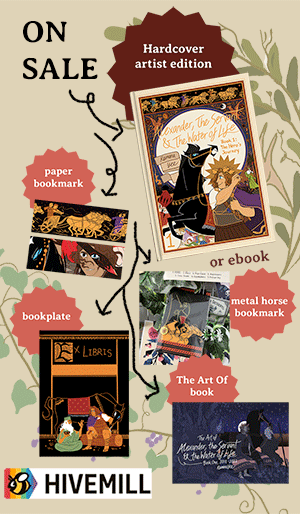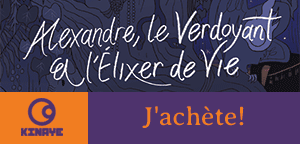Writing
This chapter is a retelling of the well-known anecdote of a young Alexander taming a horse that no adult could, launching a wonderful tradition of horse girls and their forever steeds.
I based it mostly off the "historical" account, which had Alexander and Bucephalus encounter each other through a horse merchant. However the legends are an important part of this retelling too (for example, in this spread), as a visual-narrative layer that floats above the surface of the comic and in between the panels.
Here is the story from Plutarch's Life of Alexander (Parallel Lives, Part 1.6):
Once upon a time Philoneicus the Thessalian brought Bucephalas, offering to sell him to Philip for thirteen talents, and they went down into the plain to try the horse, who appeared to be savage and altogether intractable, neither allowing any one to mount him, nor heeding the voice of any of Philip's attendants, but rearing up against all of them.
Then Philip was vexed and ordered the horse to be led away, believing him to be altogether wild and unbroken; but Alexander, who was near by, said: "What a horse they are losing, because, for lack of skill and courage, they cannot manage him!"
At first, then, Philip held his peace; but as Alexander many times let fall such words and showed great distress, he said: "Dost thou find fault with thine elders in the belief that thou knowest more than they do or art better able to manage a horse?"
"This horse, at any rate," said Alexander, "I could manage better than others have."
"And if thou shouldst not, what penalty wilt thou undergo for thy rashness?"
"Indeed," said Alexander, "I will forfeit the price of the horse."
There was laughter at this, and then an agreement between father and son as to the forfeiture, and at once Alexander ran to the horse, took hold of his bridle-rein, and turned him towards the sun; for he had noticed, as it would seem, that the horse was greatly disturbed by the sight of his own shadow falling in front of him and dancing about. And after he had calmed the horse a little in this way, and had stroked him with his hand, when he saw that he was full of spirit and courage, he quietly cast aside his mantle and with a light spring safely bestrode him. Then, with a little pressure of the reins on the bit, and without striking him or tearing his mouth, he held him in hand; but when he saw that the horse was rid of the fear that had beset him, and was impatient for the course, he gave him his head, and at last urged him on with sterner tone and thrust of foot.
Philip and his company were speechless with anxiety at first; but when Alexander made the turn in proper fashion and came back to them proud and exultant, all the rest broke into loud cries, but his father, as we are told, actually shed tears of joy, and when Alexander had dismounted, kissed him, saying: "My son, seek thee out a kingdom equal to thyself; Macedonia has not room for thee."
And a version from the Alexander Romance. (Book 1, Chapter 13, 15, 16, 17) There's a timeskip in between Philip acquiring the horse and Alexander finally claiming him.
Now at that time the princes of the Cappadocians brought as an offering to Philip from their herds of horses a foal of great size, bound with fetters of iron, for, said they, he devours men. And when Philip observed his appearance and beauty, he said to his friends, "True it is what is said in the proverb, for they say, 'something bad springs up by the side of anything good'; but now since the chiefs of the Cappadocians, my friends, have brought me a present, accept it from them, and let him be kept in restraint and guarded in an iron-barred enclosure, and let the dead bodies of evildoers, by whom crimes worthy of death have been committed, and who are appointed to be slain by the decrees of the judges, be thrown to this [beast]." And when Philip had thus spoken, they executed his orders with all speed.
[...]
Then Philip returned from whence he had gone, and sent his servants to Polias the diviner at Delphi to ask of the diviner, that he might know who would be king after him. When they drew near, and came to the fountain of Castalia, they asked an augury. And the virgin Pythia answered them saying, "Say ye to Philip, the father and lord of Macedonia, 'He that shall receive the kingdom, being sent by the gods, the rulers of the world, to this kingdom of the Macedonians, this is the sign that I have seen concerning him ; he shall make the mighty steed which is called Bucephalus (the interpretation of which is Bull-head) run through Pella.' " And when those who had been sent to bring the augury returned to Philip, they told this sign to him, and he, after he had received this augury, used to watch when he might see this sign ; and he used to enquire of every one who made a horse run through Pella what its name was and how it was called.
[...]
Now when Alexander was nearly old enough to reign, he went to a distance to the place [where Bucephalus was kept] ; and he looked and saw from the door, and went out and saw the horse guarded by on iron grating, with its whole body bound with chains; and he saw that the horse was very excited and furious. By reason of the smell of the human bones and skulls which he devoured, the place itself was foul, and the horse emitted a foetid odour from his mouth. When Alexander saw the many human bones lying under him near his feet, he questioned those who had the care of him, saying, "I want to know what is the reason that this horse is bound in this manner ?" And they said to him, "This horse is a man-eater." Now when Alexander heard this speech, he marvelled and drew near to the iron grating, and admired the strength and size and beauty of the horse. He was especially struck with wonder at his being so terrible and at his fierce appearance. And after the horse took no notice of him, he put his hands gently through the railings, and put a bit into his mouth; and the horse licked the hand of Alexander with his tongue. Then Alexander began to rub his side and legs, and he was quiet.
And when he saw that the horse was gratified, he commanded and they took away the railings from him. And he led the horse out, holding the bridle with his right hand, while with the left he stroked the horse's body, and the horse wagged his tail like a dog. And when Alexander saw that he was so gentle, he led him by the bridle and brought him out into the street, and he saw upon the right side of the horse a birthmark in the form of a wolf, a sign that was born with him, and this wolf held a bull in its mouth. Then [Alexander] mounted and rode upon him, and made him run through the city [of Pella]. Now it happened that Philip was sitting upon the wall of the city, making the horsemen pass before him by number, and he enquired of them the names of their horses, if peradventure there might be one who had a horse called Bull-head, for he had learned the augury from the diviner. And while Philip was sitting upon the wall, Alexander came up to him at a gallop; and when Philip saw Alexander guiding the horse with his hand and standing upon his feet, he said, "My son Alexander, the whole oracle refers to thee; I believe that after my death thou wilt reign, and that thou wilt rule the whole world."
The story is the same regardless, but the details!
As mentioned before, I mostly adapted Plutarch's account for my retelling of the taming of Bucephalus, with the Romance appearing in bits and pieces. Where the Romance's influence is strongest is in Bucephalus' character design.

Caption: The first character design sheet of Bucephalus, explanation below.
Bucephalus' design is representational of this mix between history and legend. (Here's the original blog post with the character sheet and design notes plus the follow-up with an updated sheet explaining how I problem solve a design) Similarly to Alexander, I based Buchy’s design on the middle ground between the descriptions in the historical record and the Romance: a black Thessalian horse, with a star on his forehead and blue eyes, with the twist being the dragon-like head and reptilian eyes, referencing the Romantic version of Buchy as a monstrous man-eating creature. His silhouette is rooted more in Greek black figure pottery than any real horse.
-
Anyway, the intent of Chapter Three was to build a few character-defining
moments that will cascade into later chapters, particularly Alexander's
dynamic with his father. To better evoke a sense of rose-tinted
childhood nostalgia, I went with a more children's book approach for the
tone and some of the visual choices, using more grawlixes than I would normally for the type of graphic novel Alexander Comic is.
Speaking of tone, the chapter also features the return of the narrator/author's voice inside the comic itself (transcript readers will have a slightly different experience) – introducing it as a metafictional element acting beyond the Prologue.
-
Since its start, I always wanted Alexander Comic to be metafiction, specifically historiographic metafiction – which is an embarrassing mouthful to say. But frankly, it's the only term that's accurate to whatever I'm trying to do here, intent and influence included.
There are a decent amount of metafiction comics, with most of them experimenting with the format (Asterios Polyp) or going all in on pop culture references (Deadpool) or the legacy of superhero comics (Watchmen). But very few centered on history/literature that's not in the point of view of a character (fictional or real, main or side), but the creator who's actually writing AND drawing AND researching the subject matter.
There's a precedent to this approach of
metafiction in prose, like Miguel Cervantes' parody of chivalric
romances and supposedly-true translations of stories from elsewhere;
Jorge Luis Borges' pseudo-review of a fictional author recreating Don
Quixote; and arguably Victor Hugo's sidenote rambles about Parisian
sewers. There's a distinctive narrator's voice in these stories, which
isn't always possible in a primarily visual medium like comics (unless
you want to write a wall of text), or perceptible to readers unfamiliar
with comics, as the narrator's presence if done successfully should be
loudest in the artwork, similar to how a director or cinematographer
frames a scene.
I am working out how to present my author's
voice in a way that's unique to comics: not a wall of text, uses
visuals, is an interaction between text and art in the way I'm trying
with comics as poetry. Basically laying out train tracks in front of me
as I go. In the Prologue it's pretty standard, with the text in a custom
font framed around the artwork, like a storybook. In this chapter, I
switched the tactic, with hand-lettering and captions.
At the moment I am leaning towards using my handwriting rather than a font just for the author's voice, kinda like a scribe's annotation at the side of the text they are copying. (The problem is I don't like how my handwriting looks when I am writing on the Huion tablet vs the iPad or paper) It's very likely that I will update these pages once I establish a solution for this. Right now, at the time of writing, you get to witness the messiness. In the future though, I will be taking advantage of gutter space and wackier ideas. Stay tuned.
-
The ending scene with young Alexander, Bucephalus and Hephaestion is completely my invention. That's all I can say without going into spoiler territory, but the choice will make sense more immediately in the next chapter, and who knows where in the comic. ;)
Thumbnailing and Sketching
Tools
Thumbnails: Moleskine notebook, mechanical pencil
Sketches: Procreate, iPad with Apple pencil
Time taken
Thumbnails: 1 hour.
Sketches: (not counting breaks) 24 hours.
Inking and Colouring
Tools
Inks: Procreate, iPad with Apple pencil, Photoshop
Colours and Letters: Photoshop
Time taken
Inks: A week-ish.
Colours: Less than a week. The one that took the most time was the Bucephalus medieval page.
Research
Following Chapter 2's take on Babylon, I took my approach regarding immersiveness up a notch with Macedon. Once again, this is still on easy mode, while I refine the approach and acclimate myself to drawing historical settings after a long break.Macedon was/is northmost of Greece, on the other side of the mountains of Olympus. One of the details that struck me while I was looking up the Macedonian landscape was how densely green it is (which lines up with the historical record of Macedon's timber being in high demand for ship-building and whatnot). So that was the first thing I wanted to depict.
I love material culture and mundanity, so those two take the stage in the establishing pages with the small details. I gave the transcript similar treatment in the description of the marketplace.
The next two chapters are going to be the most challenging I've ever done. I can only hope the amount of art and practice I have done in the past, especially of horses, will be up to task.





